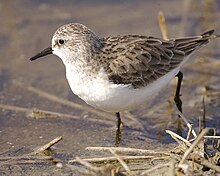Little stint
| Little stint | |
|---|---|

| |
| Non-breeding adult in Egypt | |
| Scientific classification | |
| Domain: | Eukaryota |
| Kingdom: | Animalia |
| Phylum: | Chordata |
| Class: | Aves |
| Order: | Charadriiformes |
| Family: | Scolopacidae |
| Genus: | Calidris |
| Species: | C. minuta
|
| Binomial name | |
| Calidris minuta (Leisler, 1812)
| |

| |
| Range of C. minuta Breeding Passage Non-breeding Vagrant (seasonality uncertain)
| |
| Synonyms | |
|
Erolia minuta | |

The little stint (Calidris minuta or Erolia minuta) is a very small wader. It breeds in arctic Europe and Asia, and is a long-distance migrant, wintering south to Africa and south Asia. It occasionally is a vagrant to North America and to Australia. The genus name is from Ancient Greek kalidris or skalidris, a term used by Aristotle for some grey-coloured waterside birds. The specific minuta is Latin for "small.[2]
Description
[edit]Its small size, fine dark bill, dark legs and quicker movements distinguish this species from all waders except the other dark-legged stints. It can be distinguished from these in all plumages by its combination of a fine bill tip, unwebbed toes and long primary projection. The call is a sharp "stit".
The breeding adult has an orange wash to the breast, a white throat and a strong white V on its back. In winter plumage identification is difficult. Juveniles have pale crown stripes and a pinkish breast.
An apparent hybrid between this species and Temminck's stint has been reported from the Netherlands.[3]
Population dynamics
[edit]The numbers of this species (and of curlew sandpiper) depend on the population of lemmings. In poor lemming years, predatory species such as skuas and snowy owls take Arctic-breeding waders instead.
It is gregarious in winter, sometimes forming large flocks with other Calidris waders, particularly dunlin, on coastal mudflats or the edges of inland pools.
The little stint is one of the species to which the Agreement on the Conservation of African-Eurasian Migratory Waterbirds (AEWA) applies.
Nesting
[edit]This bird nests on a scrape in bare ground, laying 3–5 eggs. It is polygamous, and males and females may incubate separate clutches.

Food
[edit]Food is small invertebrates picked off the mud.
Gallery
[edit]References
[edit]- ^ BirdLife International (2019). "Calidris minuta". IUCN Red List of Threatened Species. 2019: e.T22693379A138406063. doi:10.2305/IUCN.UK.2019-3.RLTS.T22693379A138406063.en. Retrieved 1 September 2024.
- ^ Jobling, James A (2010). The Helm Dictionary of Scientific Bird Names. London: Christopher Helm. pp. 84, 256. ISBN 978-1-4081-2501-4.
- ^ Jonsson, Lars (1996). "Mystery stint at Groote Keeten: First known hybrid between Little and Temminck's Stint?". Dutch Birding. 18: 24–28.
Further reading
[edit]Identification
[edit]- Jonsson, Lars; Grant, Peter J. (1984). "Identification of stints and peeps". British Birds. 77 (7): 293–315.
External links
[edit]- Little stint species text in The Atlas of Southern African Birds
- Little stint photos at Oiseaux.net
- Ageing and sexing (PDF; 1.2 MB) by Javier Blasco-Zumeta & Gerd-Michael Heinze
- BirdLife species factsheet for Calidris minuta
- "Calidris minuta". Avibase.
- "Little stint media". Internet Bird Collection.
- Little stint photo gallery at VIREO (Drexel University)
- Interactive range map of Calidris minuta at IUCN Red List maps
- Audio recordings of Little stint on Xeno-canto.
- Calidris minuta in Field Guide: Birds of the World on Flickr
- Little stint media from ARKive





